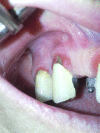Diode laser assisted excision of a gingival pyogenic granuloma: A case report
- PMID: 31579498
- PMCID: PMC6755259
- DOI: 10.4081/cp.2019.1179
Diode laser assisted excision of a gingival pyogenic granuloma: A case report
Abstract
Pyogenic granuloma is a non-neoplastic, exuberant, reactive lesion seen in response to local irritation or trauma caused by dental calculus, bacterial plaque, caries and restorations, with a strong predilection for the gingiva. It is among the frequently encountered oral lesions, occurring at a challenging oral site, the gingiva. Herein, we report a 71-year-old medically compromised Caucasian female who presented with a relatively large lobulated pyogenic granuloma on the buccal gingiva of the maxillary molar-premolar region. Total surgical excision was performed with an 840nm diode laser followed by the placement of hyaluronate gel and relevant periodontal dressing. Two weeks after surgical excision, complete healing was observed, but patient denied replacement of dental restoration. After 4 months of follow-up, an overall reduction of associated teeth mobility was also observed, with a minor recurrence in gingival inflammation. The objective of this report is to briefly review clinical, radiographic and histological findings of pyogenic granuloma along with a detailed discussion on its management through a diode laser.
Keywords: Diode laser; Gingiva; Laser surgery; Pyogenic granuloma.
©Copyright: the Author(s), 2019.
Conflict of interest statement
Conflict of interest: the authors declare no potential conflict of interest.
Figures






Similar articles
-
A Clinical Report of Solitary Gingival Overgrowth in a Young Female Patient.J Pharm Bioallied Sci. 2019 May;11(Suppl 2):S491-S494. doi: 10.4103/JPBS.JPBS_8_19. J Pharm Bioallied Sci. 2019. PMID: 31198394 Free PMC article.
-
Management of a Recurrent Pyogenic Granuloma of the Hard Palate with Diode Laser: A Case Report.J Lasers Med Sci. 2016 Winter;7(1):56-61. doi: 10.15171/jlms.2016.12. Epub 2016 Jan 7. J Lasers Med Sci. 2016. PMID: 27330700 Free PMC article.
-
Excision of oral pyogenic granuloma in a diabetic patient with 940nm diode laser.Saudi Med J. 2016 Dec;37(12):1395-1400. doi: 10.15537/smj.2016.12.15941. Saudi Med J. 2016. PMID: 27874157 Free PMC article.
-
CO2 Laser Excision of a Pyogenic Granuloma Associated with Dental Implants: A Case Report and Review of the Literature.Photomed Laser Surg. 2016 Sep;34(9):425-31. doi: 10.1089/pho.2016.4089. Epub 2016 Jul 15. Photomed Laser Surg. 2016. PMID: 27420917 Review.
-
Heterogeneous conceptualization of etiopathogenesis: Oral pyogenic granuloma.Natl J Maxillofac Surg. 2019 Jan-Jun;10(1):3-7. doi: 10.4103/njms.NJMS_55_18. Natl J Maxillofac Surg. 2019. PMID: 31205381 Free PMC article. Review.
Cited by
-
Diode laser versus sclerotherapy: bloodless approaches in the treatment of oral pyogenic granuloma (randomised controlled clinical trial).Odontology. 2023 Apr;111(2):511-521. doi: 10.1007/s10266-022-00759-9. Epub 2022 Oct 28. Odontology. 2023. PMID: 36307616 Free PMC article. Clinical Trial.
-
A Single Case Report of Granular Cell Tumor of the Tongue Successfully Treated through 445 nm Diode Laser.Healthcare (Basel). 2020 Aug 13;8(3):267. doi: 10.3390/healthcare8030267. Healthcare (Basel). 2020. PMID: 32823546 Free PMC article.
-
Laser Excisional Biopsy of Bleeding Tumor near Newly Erupted Tooth in an 11-Month-Old Patient under General Anesthesia.Case Rep Dent. 2024 Jan 18;2024:6668716. doi: 10.1155/2024/6668716. eCollection 2024. Case Rep Dent. 2024. PMID: 38274320 Free PMC article.
References
-
- Gex-Collet C, Itin P, Scherer K. Pyogenic granuloma treated with pulsed Nd:YAG (1064 nm) laser- A case series. Med Laser Appl 2008;23:115-9.
-
- Hammes S, Kaiser K, Pohl L, et al. Pyogenic granuloma: treatment with the 1,064-nm long-pulsed neodymiumdoped yttrium aluminum garnet laser in 20 patients. Dermatol Surg 2012;38: 918-23. - PubMed
-
- Chaya D, Pankaj G. Lasers in dentistry: a review. Int J Adv Health Sci 2015;2:7-13.
LinkOut - more resources
Full Text Sources
